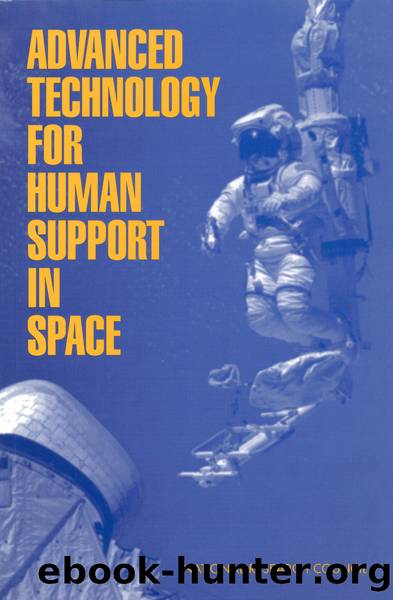Advanced Technology for Human Support in Space by Committee on Advanced Technology for Human Support in Space

Author:Committee on Advanced Technology for Human Support in Space
Language: eng
Format: epub
Tags: Space and Aeronautics: Space Systems and Hardware
Publisher: NATIONAL ACADEMY PRESS
Published: 1911-11-11T00:00:00+00:00
Rationale for Monitoring
A basic purpose of monitoring is to diagnose and feed back information to a warning or control procedure, so that the risk of unacceptable exposures is minimized. The value of monitoring is reduced if control will be too slow to prevent or significantly diminish negative health effects, or if no control is possible. For example, 90-day intervals between monitoring events for agents of infectious disease, as planned for the ISS, may be too long to be of significant use for crew protection. The incubation period for most infectious diseases is significantly less than 90 days, and many diseases are likely to run their course before they are indicated by the currently planned monitoring system. In some cases, no interval sampling technique is likely to be effective. For example, contagious and waterborne virulent diseases can develop following single, low-level exposure events. Therefore, if any exposure occurs, environmental monitoring is likely to be too late, and measures to prevent additional cases must focus on the isolation and treatment of infected individuals or sources of contaminants. Useful environmental monitoring to control such diseases would have to focus on very low detection limits (single agents in large volumes of air/water) in real time.
Even when control of exposure is not possible, however, monitoring may produce valuable data for the design of future missions, or may indicate the presence of agents that could pose a future risk of disease. Monitoring for infectious agents involves identifying specific reservoirs and developing monitoring protocols based on background data and risk assessments that include the nature of the agent, the probability of presence and exposure, as well as likely levels of infectious agents and variability over time. These kinds of detailed assessments regarding when and how monitoring should be used would enhance the viability and cost-effectiveness of operational EMC programs planned for future missions. The baseline plan for the ISS is still based on culture methods to detect bacteria. Standard microbiological techniques encourage fungi and bacteria to grow in the space environment. Given the close quarters and closed environment of the ISS, this technique should be reevaluated (especially for fungi, which produce spores that readily become airborne). Table 3-3 shows a general outline for the prioritization and use of monitoring and control schemes.
TABLE 3-3 Microbiological Monitoring and Control Prioritization
Procedural Steps
Description
Download
This site does not store any files on its server. We only index and link to content provided by other sites. Please contact the content providers to delete copyright contents if any and email us, we'll remove relevant links or contents immediately.
| Aeronautics & Astronautics | Astronomy |
| Astrophysics & Space Science | Comets, Meteors & Asteroids |
| Cosmology | Mars |
| Solar System | Star-Gazing |
| Telescopes | UFOs |
Tools of Titans by Timothy Ferriss(8311)
Turbulence by E. J. Noyes(7983)
Secrets of Antigravity Propulsion: Tesla, UFOs, and Classified Aerospace Technology by Ph.D. Paul A. Laviolette(5336)
Astrophysics for People in a Hurry by Neil DeGrasse Tyson(5153)
Room 212 by Kate Stewart(5073)
Design of Trajectory Optimization Approach for Space Maneuver Vehicle Skip Entry Problems by Runqi Chai & Al Savvaris & Antonios Tsourdos & Senchun Chai(5040)
Pale Blue Dot by Carl Sagan(4960)
The David Icke Guide to the Global Conspiracy (and how to end it) by David Icke(4659)
A Journey Through Divination and Astronomy by Publishing Pottermore(4364)
Goodbye Paradise(3767)
Apollo 8 by Jeffrey Kluger(3673)
COSMOS by Carl Sagan(3593)
The Five People You Meet in Heaven by Mitch Albom(3522)
Losing the Nobel Prize by Brian Keating(3521)
How to Read Water: Clues and Patterns from Puddles to the Sea (Natural Navigation) by Tristan Gooley(3434)
Brief Answers to the Big Questions by Stephen Hawking(3394)
How to Read Nature by Tristan Gooley(3294)
The Order of Time by Carlo Rovelli(3164)
A Brief History of Time by Stephen Hawking(2994)
